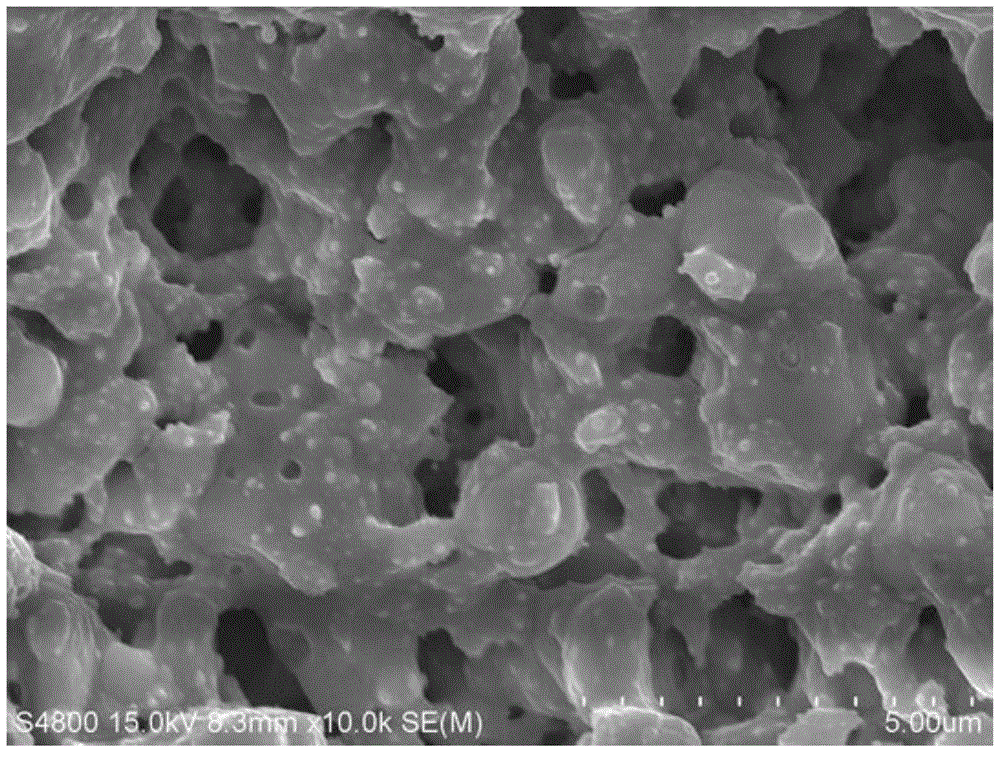Preparation method of visible light absorption layer based on Ag3PO4 film
An absorption layer and visible light technology, applied in the field of photoelectric material preparation and photocatalysis, can solve the problems of difficult recovery of base photocatalyst, difficult photoelectric energy conversion, etc., and achieve the effect of low cost, easy thickness control and good adhesion.
- Summary
- Abstract
- Description
- Claims
- Application Information
AI Technical Summary
Problems solved by technology
Method used
Image
Examples
preparation example Construction
[0018] The preparation method of the visible light absorbing layer is: it is prepared by using the four-step process of "co-precipitation-spin coating-drying-sintering". Steps: 1) Obtain Ag by co-precipitation method 3 PO 4 Nano-scale powder, the size of the powder is in the range of 20-500nm; 2) the Ag 3 PO 4 The powder is dissolved and dispersed in a transparent organic carrier to obtain a precursor sol, and then the obtained precursor sol is spin-coated on the substrate by spin coating to obtain a prefabricated Ag 3 PO 4 thin film; 3) the prefabricated Ag 3 PO 4 The film is dried in an oven at 20-80°C; 4), the dried Ag 3 PO 4 The prefabricated film is sintered in a muffle furnace to remove organic solvent residues.
[0019] The transparent organic carrier is composed of terpineol and ethyl cellulose, and their mass ratio is 10:1˜5:1.
[0020] Ethyl cellulose and Ag in the precursor sol 3 PO 4 The mass ratio of the powder is 0.03:1-0.1:1.
[0021] The heat preserv...
Embodiment 1
[0022] Example 1: Using fluorine tin oxide (FTO) conductive glass as the substrate, add 0.4g ethyl cellulose to 5mL terpineol, stir at room temperature for 24h to obtain a transparent viscous liquid, take 0.5g prepared by coprecipitation method Ag 3 PO 4 Grind for 30 minutes, add to 375 μL of the above transparent viscous liquid, and stir for 2 hours to obtain a gel. Put the FTO conductive glass on the glue leveler, drop the gel in the center, spin-coat at a low speed of 1000r / min for 10s, and then spin-coat at a high speed of 3000r / min for 60s to obtain a thin film. The spin-coated film was dried in an oven at 60 °C for 12 h, and then sintered in a muffle furnace. Raise the temperature from room temperature to 125°C at a rate of 1°C / min, hold for 30 minutes, then raise the temperature to 400°C at a rate of 10°C / min, hold for 90 minutes, and cool naturally to room temperature to obtain a firmer film. Ag to be prepared 3 PO 4 The base film is used in dye-sensitized solar c...
Embodiment 2
[0023] Example 2: Using indium tin oxide (ITO) conductive glass as the substrate, add 0.4g ethyl cellulose to 4.5mL terpineol, stir at 60°C for 12h to obtain a transparent viscous liquid, take 0.4gAg 3 PO 4 Grind for 30 minutes, add to 225 μL of the above transparent viscous liquid, and stir for 2 hours to obtain a gel. The thin film was obtained by doctor blade method, dried in an oven at 50°C for 12h, and then sintered in a muffle furnace. Raise the temperature from room temperature to 125°C at a rate of 1°C / min, hold for 30 minutes, then raise the temperature to 375°C at a rate of 10°C / min, hold for 90 minutes, and cool naturally to room temperature to obtain a firmer film. Ag to be prepared 3 PO 4 The base film photoanode is used in the electrochemical workstation, the Pt electrode is used as the counter electrode, the calomel electrode is used as the reference electrode, and 0.1M potassium nitrate aqueous solution is used as the electrolyte.
PUM
 Login to View More
Login to View More Abstract
Description
Claims
Application Information
 Login to View More
Login to View More - R&D
- Intellectual Property
- Life Sciences
- Materials
- Tech Scout
- Unparalleled Data Quality
- Higher Quality Content
- 60% Fewer Hallucinations
Browse by: Latest US Patents, China's latest patents, Technical Efficacy Thesaurus, Application Domain, Technology Topic, Popular Technical Reports.
© 2025 PatSnap. All rights reserved.Legal|Privacy policy|Modern Slavery Act Transparency Statement|Sitemap|About US| Contact US: help@patsnap.com



